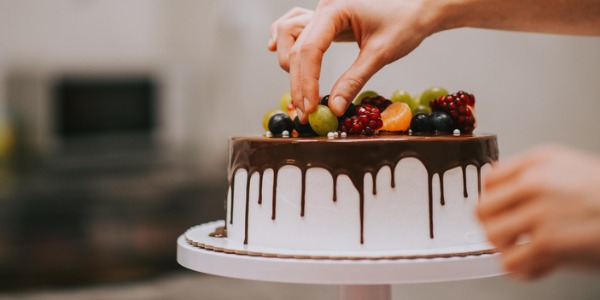What is a Cake Designer?
A cake designer specializes in creating custom-designed cakes for various occasions and events. These cakes are not only delicious but also visually stunning, often serving as the centerpiece of celebrations such as weddings, birthdays, anniversaries, and other special events.
Cake designers work closely with clients to understand their specific needs, preferences, and budget constraints. They collaborate with them to conceptualize the design, discussing elements such as flavors, colors, decorations, and any special requests or themes. Once the design is finalized, cake designers meticulously execute their vision, using a combination of baking, frosting, icing, and decorating techniques to create intricate and elaborate cakes that are both visually stunning and delicious.
What does a Cake Designer do?

Duties and Responsibilities
The duties and responsibilities of a cake designer encompass a variety of tasks related to the creation of custom-designed cakes for special occasions. Here are some typical duties:
- Consultation with Clients: Meet with clients to discuss their cake design preferences, including flavors, colors, themes, and budget considerations. Provide guidance and recommendations based on the client's vision and requirements.
- Design Development: Create sketches, mock-ups, or digital renderings of cake designs to present to clients for approval. Collaborate with clients to refine and finalize the design, ensuring it meets their expectations.
- Baking and Preparation: Prepare cake batter, fillings, and frostings according to recipes and client specifications. Bake cakes to perfection, ensuring they are moist, flavorful, and of the highest quality.
- Cake Decoration: Use various decorating techniques, such as piping, fondant work, sugar crafting, and edible painting, to decorate cakes with intricate designs, patterns, and motifs. Pay close attention to detail to achieve flawless execution.
- Assembly and Construction: Assemble and stack cake layers, fillings, and frostings to create multi-tiered cakes. Ensure structural stability and integrity, using dowels or supports as needed to prevent collapsing.
- Transportation and Delivery: Safely transport finished cakes to the event venue, taking precautions to prevent damage during transit. Set up cakes on-site, ensuring they are displayed prominently and securely.
- Client Communication: Maintain open communication with clients throughout the design and production process, providing updates, addressing any concerns or changes, and ensuring client satisfaction.
- Cleanliness and Sanitation: Adhere to strict cleanliness and sanitation standards in the kitchen, ensuring all equipment, tools, and work surfaces are properly sanitized and maintained.
- Inventory Management: Manage inventory of cake decorating supplies, ingredients, and tools, ensuring adequate stock levels and proper storage to minimize waste and ensure freshness.
- Continuous Learning: Stay informed about current trends, techniques, and innovations in cake design by attending workshops, seminars, and industry events. Continuously seek opportunities for professional development and skill enhancement.
Types of Cake Designers
There are several types of cake designers, each with their own style and area of expertise. Here are a few examples:
- Wedding Cake Designers: Specializes in creating custom-designed wedding cakes tailored to the couple's preferences, wedding theme, and style. Wedding cake designers often work closely with brides and grooms to create elegant and sophisticated cakes that serve as the centerpiece of the wedding reception.
- Special Occasion Cake Designers: Focuses on designing cakes for special occasions such as birthdays, anniversaries, baby showers, graduations, and other milestone events. Special occasion cake designers excel at creating themed cakes that reflect the personality and interests of the celebrants.
- Sculpted Cake Designers: Specializes in sculpting and carving cakes into intricate shapes, figures, or objects. Sculpted cake artists use their creativity and technical skills to transform cake into edible works of art, often depicting animals, vehicles, landmarks, or characters.
- Sugar Flower Designers: Specializes in crafting delicate and lifelike flowers and botanicals out of sugar paste. Sugar flower designers meticulously sculpt and assemble sugar flowers to adorn cakes, creating stunning floral arrangements that mimic nature.
- Chocolate Cake Designers: Specializes in creating cakes made entirely of chocolate or incorporating chocolate into the design. Chocolate cake designers use a variety of techniques to create intricate chocolate decorations and designs, often incorporating flavors such as fruit, nuts, or spices.
What is the workplace of a Cake Designer like?
The workplace of a cake designer is typically a creative and bustling environment, often located within a dedicated cake studio, bakery, or pastry shop. Within this space, cake designers have access to a variety of tools, equipment, and ingredients necessary for creating their edible masterpieces. The atmosphere is usually vibrant and lively, with the aroma of freshly baked cakes and the sound of mixers in the background, creating an inspiring setting for creativity to flourish.
Cake designers often have their own workstation or kitchen area within the larger bakery or studio, equipped with everything they need to bring their cake designs to life. This includes work surfaces for rolling out fondant or buttercream, storage areas for cake layers and fillings, and a wide array of decorating tools such as piping bags, spatulas, and sculpting tools. Additionally, cake designers may have access to specialized equipment such as cake turntables, airbrush machines, and edible printers to help them achieve their desired designs.
Collaboration is often a key aspect of the cake designer's workplace, with designers working closely with clients to bring their visions to fruition. This may involve consultations with clients to discuss design concepts, tastings to sample cake flavors and fillings, and follow-up meetings to finalize details and make any necessary adjustments. In addition to client interactions, cake designers may also collaborate with other members of the bakery or studio team, such as pastry chefs, bakers, and decorators, to coordinate production schedules and ensure that orders are completed to the highest standards.
Frequently Asked Questions
Pastry and Baking Related Careers and Degrees
Cake Designers are also known as:
Cake Artist